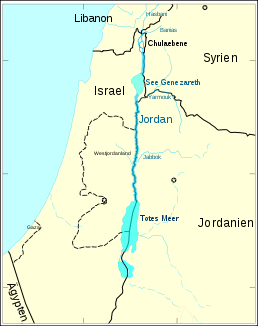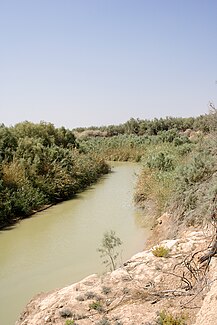Jordan
| Jordan | ||
| Data | ||
| location | Palestine (region) | |
| River system | Jordan | |
| origin | Confluence of the Dan , Hazbani and Banyas rivers 33 ° 11 ′ 12 ″ N , 35 ° 37 ′ 9 ″ E |
|
| Source height | approx. 80 m | |
| muzzle |
Dead Sea coordinates: 31 ° 45 ′ 41 ″ N , 35 ° 33 ′ 30 ″ E 31 ° 45 ′ 41 ″ N , 35 ° 33 ′ 30 ″ E |
|
| Mouth height | approx. 415 m below sea level | |
| Height difference | approx. 495 m | |
| Bottom slope | approx. 2 ‰ | |
| length | 251 km | |
| Runoff estimate |
MQ |
6 m³ / s |
| Left tributaries | Jarmuk , Jabbok | |
| Flowing lakes | Galilee | |

The Jordan ( Hebrew נהר הירדן , analogously "the descending river"; Arabic نهر الأردن, DMG nahr al-Urdunn ) is a river in the Middle East . According to Jewish tradition, the Jordan formed the border between the land of Israel and the other "peoples" after the so-called conquest .
Geography of the river
The source rivers of the Jordan - the Hasbani in Lebanon , the Dan in northern Israel and the Banyas (also called Hermon River) in the northern Golan Heights - arise in the area around the Hermon Mountains . They unite in the area around Sede Nehemija to the Jordan, which then crosses the Hule Plain of Northern Galilee in a southerly direction before flowing into the Sea of Galilee at Bethsaida . To the south of the lake it enters the Jordan Rift and, in its further course, takes up the only two larger tributaries, Jarmuk and Jabbok , on the left. To the southeast of Jericho it flows into the Dead Sea , an end-lake with no outflow .
The length of the Jordan is given as 251 km. The distance (as the crow flies) between the confluence of its source rivers and its mouth in the Dead Sea is about 170 km. For the section between the Sea of Galilee and the Dead Sea, a length of 210 km is given with numerous curves, although the two lakes are only 105 km apart and the Jordan connects their facing banks.
In almost the entire southern course of the river (with the exception of the stretch from the Sea of Galilee to Bet She'an ) the Jordan forms the border between Israel and Jordan . In the northern area, it flows along the Israeli-occupied and claimed by Syria Golan Heights.
The Jordan Rift with the Dead Sea forms a geological depression and, as a transform fault, is highly prone to earthquakes.
For the geology and hydrology of the Jordan and its surroundings, see Palestine (region) .
Political importance
Due to its border location, the Jordan plays an important role in the politics of the Middle East. The Jordan carries a comparatively large amount of water all year round. Israel regards the river and the Sea of Galilee as a central element of the drinking water supply, the other neighboring states (Lebanon, Syria and Jordan) for their part demand an appropriate share of the water in the river system.
In the relationship between Israel and Jordan, the river was able to contribute to peace. Article 6 of the Israeli-Jordanian peace treaty , which was signed in Washington on October 26, 1994 by King Hussein of Jordan , Israeli Prime Minister Yitzchak Rabin and US President Bill Clinton , contains the contractual assurance that Jordan will have larger quantities of drinking water from the river may take. In relation to Israel's relationship with Syria, the Jordan is more of a contributing factor to the crisis: The concern that Syria could "dig up the waters" of Israel is a major reason why Israel refuses to return the Golan Heights.
See also: Jordan water issue
Water use
The Jordan is the main source of fresh water for both Israel and Jordan. For example, of the 1200 million cubic meters of water that the Jordan carries each year, 500 million cubic meters are taken from the Sea of Galilee by Israel alone. This water is mainly used to irrigate agriculture in the Negev desert and to supply the cities with drinking water. Due to the constant withdrawal of water, the Jordan degenerates into a trickle of sewage. Every year only 200 million cubic meters of water flow into the Dead Sea, which leads to a dramatic decrease in its water level.
Religious meaning
In Judaism , the Jordan is important as the river that the people of Israel crossed when they took their land after wandering through the desert under the leadership of Joshua ( Jos 3 EU ).
In the area around Jericho, the place is located where, according to New Testament tradition, Jesus was baptized by John the Baptist . This significant event for Christians made the Jordan a highly frequented pilgrimage destination with numerous baptismal sites, such as in Jardenit at the southern end of the Sea of Galilee. Jordan water is also sometimes used for baptisms in other places, for example the English Prince George of Cambridge or the Spanish Princess Sofía de Borbón y Ortiz were baptized with Jordan water.
Its crossing as a transition from the hostile alien to the land of promise is therefore often used as an allegory for dying, as is the case with the German saying “to go across the Jordan”.
literature
- Georg Beer : Jordanes 1 . In: Paulys Realencyclopadie der classischen Antiquity Science (RE). Volume IX, 2, Stuttgart 1916, Col. 1903-1907.
- Gerhard Konzelmann : The Jordan. Primordial stream between salvation and hate. Hoffmann and Campe, Hamburg 1990, ISBN 3-455-08313-7 .
Web links
- Frank Tetzel: Water management in the Middle East, source of conflict
swell
- ↑ Baptism of Prince Geoge with Jordan water on the side of the world on October 23, 2013, accessed on July 17, 2019
- ↑ Königlicher Fratz with Jordanwasser baptized on the page of the world on July 20, 2007, accessed on July 17, 2019
- ^ Rudolf Köster: Proper names in the German vocabulary . Walter de Gruyter 2003, ISBN 978-3-11-017701-5 , p. 83 ( limited preview in the Google book search)
- ↑ Olga Ejikhine: Taken literally: The phrasebook through the world of idioms . Digitalis Books 2006, ISBN 978-90-77713-05-1 , p. 208 ( limited preview in Google book search)


